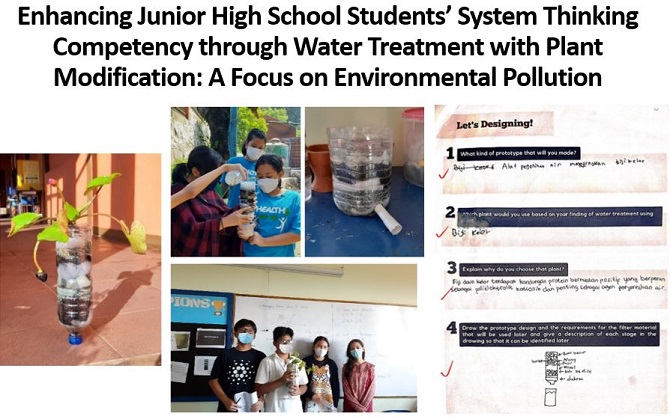
Enhancing Junior High School Students’ System Thinking Competency through Water Treatment with Plant Modification: A Focus on Environmental Pollution
Abstract
The research on the ability to think in systems in education is also minimal, which is why the ability to think in systems in Indonesia has not been optimally trained. Dealing with a system's complexity can be challenging at any age, particularly for students who must apply the system's cognitive capabilities during the learning process. Systems thinking is a key to Education for Sustainable Development (ESD) competency since it can help learners understand the complexity and dynamics of the world. This research investigates the impact of system thinking on Junior High School students through simple science projects addressing environmental pollution. The study involved 7th-grade students in a private school in Bandung, utilizing a quantitative approach with a one-group pre-test and post-test design; the research aimed to measure the improvement in students' system thinking competency using test items and analyzed the data with SPSS software and Rasch Stacking and Racking. Results from the Wilcoxon test indicated a significant difference after completing learning activities, with a 50% improvement based on Rasch analysis. This underscored the critical role of project-based learning in enhancing system thinking competency. Applying appropriate learning models is expected to enhance students' system thinking competency. The recommendation for future reference to other studies, such as directing the scientific investigation in detail. Design more precisely from the initial stage to the final stage so that the expected learning can be achieved, and students can go through all stages of STEM learning correctly to create a better prototype.
Full Text:
Download PDFReferences
Ariyatun, A., Ningrum, P., Musyarofah, M., & Inayah, N. (2018). Analisis Efektivitas Biji Dan Daun Kelor (Moringa Oleifera) Untuk Penjernihan Air. Walisongo Journal Of Chemistry, 1(2), 60. https://doi.org/10.21580/wjc.v2i2.3103
Boone, W. J. (2016). Rasch analysis for instrument development: Why, when, and how?. CBE—Life Sciences Education, 15(4), rm4.
Cebrián, G., Palau, R., & Mogas, J. (2020). The smart classroom as a means to the development of ESD methodologies. Sustainability, 12(7), 3010.
Clark, S., Petersen, J. E., Frantz, C. M., Roose, D., Ginn, J., & Daneri, D. R. (2017). Teaching Systems Thinking To 4th And 5th Graders Using Environmental Dashboard Display Technology. Plos ONE, 12(4), 1–11. https://doi.org/10.1371/journal.pone.0176322
Creswell, J. W., & Creswell, J. D. (2017). Research design: Qualitative, quantitative, and mixed methods approaches. Sage publications.
De Haan, G. (2006). The BLK ‘21’ Programme In Germany: A ‘Gestaltungskompetenz’-Based Model For Education For Sustainable Development. Environmental Education Research, 12(1), 19–32. https://doi.org/10.1080/13504620500526362
Etikan, I. (2016). Comparison Of Convenience Sampling And Purposive Sampling. American Journal Of Theoretical And Applied Statistics, 5(1), 1. https://doi.org/10.11648/j.ajtas.20160501.11
Fanta, D., Braeutigam, J., & Riess, W. (2020). Fostering Systems Thinking In Student Teachers Of Biology And Geography–An Intervention Study. Journal Of Biological Education, 54(3), 226–244. https://doi.org/10.1080/00219266.2019.1569083
Fraenkel, J. R., Wallen, N. E., & Hyun, H. H. (2012). A Guided Tour Of How To Design And Evalaute Research In Education. How To Design And Evaluate Research In Education, 1–29.
Hidayatno, A. (2016). Berpikir sistem: pola berpikir untuk pemahaman masalah yang lebih baik [Systems thinking: patterns of thinking for better understanding of problems]. Research Gate.
Hoffmann, T., & Siege, H. (2018). What is education for sustainable development (ESD). Human Development, 1(8), 1-6.
January, E., Putra, H. S. C., & Zairinayati, Z. (2021). Penggunaan Lidah Buaya (Aloe Vera) Sebagai Koagulan Alami Untuk Menurunkan Kekeruhan Air. Ruwa Jurai: Jurnal Kesehatan Lingkungan, 15(1), 23. https://doi.org/10.26630/rj.v15i1.2152
Kanabkaew, T., & Puetpaiboon, U. (2004). Aquatic Plants For Domestic Wastewater Treatment: Lotus (Nelumbo Nucifera) And Hydrilla (Hydrilla Verticillata) Systems. Aquatic, 26(5), 749–756.
Kartini, F. S., Widodo, A., Winarno, N., & Astuti, L. (2021). Promoting Student's Problem-Solving Skills through STEM Project-Based Learning in Earth Layer and Disasters Topic. Journal of Science Learning, 4(3), 257-266.
Mambrey, S., Timm, J., Landskron, J. J., & Schmiemann, P. (2020). The Impact Of System Specifics On Systems Thinking. Journal Of Research In Science Teaching, 57(10), 1632–1651. https://doi.org/10.1002/tea.21649
Nuraeni, R., Setiono, & Himatul, A. (2020). Profil Kemampuan Berpikir Sistem Siswa Kelas XI SMA Pada Materi Sistem Pernapasan. Pedagogi Hayati, 4(1), 1–9. https://doi.org/10.31629/ph.v4i1.2123
Osunji, O. (2021). Relationship Between Consciousness About Environmental Education Concepts In Secondary School Chemistry Curriculum And Attitude Of Students Towards Environment. Science Education International, 32(1), 80–84. https://doi.org/10.33828/sei.v32.i1.9
Riess, W., & Mischo, C. (2010). Promoting Systems Thinking Through Biology Lessons. International Journal Of Science Education, 32(6), 705–725. https://doi.org/10.1080/09500690902769946
Schuler, S., Fanta, D., Rosenkraenzer, F., & Riess, W. (2018). Systems Thinking Within The Scope Of Education For Sustainable Development (ESD)–A Heuristic Competence Model As A Basis For (Science) Teacher Education. Journal Of Geography In Higher Education, 42(2), 192–204. https://doi.org/10.1080/03098265.2017.1339264
Streveler, R. A., Litzinger, T. A., Miller, R. L., & Steif, P. S. (2008). In The Engineering Sciences: Overview And Future Research Directions. Journal Of Engineering Education, July, 279–294.
UNESCO. (2017). Changing minds, not the climate. https://unesdoc.unesco.org/ark:/48223/pf0000245977
Wright, B. D. (2003). Rack and Stack: Time 1 vs. Time 2. Rasch measurement transactions, 17(1), 905-906. http://www.rasch.org/rmt/rmt171a.htm
Yadav, R. K., Sahoo, S., Yadav, A. K., & Patil, S. A. (2021). Epipremnum Aureum Is A Promising Plant Candidate For Developing Nature-Based Technologies For Nutrients Removal From Wastewaters. Journal Of Environmental Chemical Engineering, 9(5), 106134. https://doi.org/10.1016/j.jece.2021.106134
DOI: https://doi.org/10.17509/jsl.v7i1.61674
Refbacks
- There are currently no refbacks.
Copyright (c) 2024 Mariah Syifa Salsabila, Yayan Sanjaya, Eliyawati Eliyawati, Witsanu Suttiwan

This work is licensed under a Creative Commons Attribution-ShareAlike 4.0 International License.


Jl. Dr. Setiabudhi 229 Bandung 40154, West Java, Indonesia










